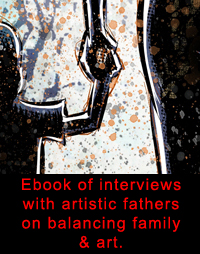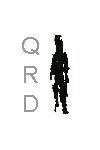
March 2014

City: Baltimore, MD
Comics: Jikoshia, A Day In The Life Of My Cats, Cranky Cthulhu
Websites: www.waywardstudios.net, www.squarecitycomics.com
QRD – How old were you when you first got into comics & did you always stick with them or did you come back to them?
Emily – I’ve loved comics as long as I can remember, though I didn’t start taking them seriously until I was in college when I was around 18 & first read Will Eisner’s A Contract With God Trilogy.
QRD – What was the first comic book you ever bought?
Emily – I honestly can’t remember my first one, though I remember stealing my sister’s copies of Garfield books as a kid.
QRD – How old were you when you put out your first comic?
Emily – The first comic I remember making was in the 4th grade. I made a comic about my teacher called Super Arnold. She defeated aliens by giving them math homework. It was ribbon bound & everything!
QRD – What decade do you think produced the best comics?
Emily – While I have favorite books from all the way back to the 40s, I really love what people have been doing with comics more recently. I’d say the current decade has the best stuff.
QRD – Why comics instead of just writing or drawing?
Emily – I’ve attempted novel writing, but it just doesn’t cut it for me. I explain things better with pictures rather than words & I’ve always enjoyed drawing.
QRD – Do you see mini-comics & indie comics as paths to mainstream comics or as their own unique media?
Emily – Both. Yes, a number of artists & authors have gotten picked up by mainstream publishers because of their indie work, but I doubt that’s the reason they started putting their work out there in the first place.
QRD – How many copies of your comic do you print in your first run?
Emily – On my main project, Jikoshia, I did a first run of 100 books. On my mini-comics, I usually start with about 20 books.
QRD – How much do you think comics should cost?
Emily – It depends on the book. I’m willing to pay $20-25 for a trade comic, but I don’t like to pay more than $5 for a mini or floppy unless they did something special with the printing (i.e. screen printed covers). I can’t see myself spending more than $50 on a special edition of a book (which I have done).
QRD – How many books do you produce a year & how many would you like to?
Emily – I typically put out 1 mini a year & 2 chapters of my main project, releasing that in book format every 2 years. Ideally, I’d like to put out 3-4 mini comics & a full trade a year.
QRD – Do you think stories should be serialized or delivered as complete works?
Emily – Again, it really depends on the story. Something particularly long should probably be serialized to make it affordable. As a consumer though, I prefer completed books. They look nicer on my shelf & are easier to browse through than floppies. Plus cliffhangers drive me INSANE.
QRD – How are comic strips different than comic books & which medium do you prefer?
Emily – Strips are more often used for one-off gags with fewer, static panels, whereas a book usually has a longer plot-driven narrative. Strips are easier to jump into & share with people, but more often I find book format to be a more rewarding read & a better fit for the kinds of stories I want to tell.
QRD – How long is it from when you start a comic until it’s printed?
Emily – My first book was printed shortly after I finished the last pages. My minis get printed whenever the nearest convention date approaches, so the wait time between book completion & printing varies.
QRD – What do you do better with your comics now than when you first started?
Emily – Just about everything! My anatomy is better. My sense of composition is better. My inking has improved. I know I still have plenty I can improve upon, but I’ve come a long way as well.
QRD – Do you do thumbnails?
Emily – I do, though they’re usually unreadable to anyone but myself (unless I draw them too far in advance, then it’s anyone’s guess).
QRD – At what size do you draw?
Emily – 150% the actual print size which fits on 11x17 paper.
QRD – What kind of pens do you use?
Emily – I vary between a variety of Microns & a Pentel Pocket Brush, though I’ve been meaning to play with nibs & brushes.
QRD – What does your workstation look like?
Emily – A cluttered computer desk with 2 monitors (one scratched), a ceramic mug I got from Renn Faire full of pens & pencils, a large Intuos tablet at my feet, & a cat sleeping on whatever page I happen to be trying to work on.
QRD – At what point in the artistic process do you work digitally?
Emily – Minor corrections, coloring, & lettering are all digital.
QRD – What do you think of digital comics & webcomics?
Emily – I LIVE webcomics. There’s just such a huge variety of stories & styles to pick from now & it’s so easy for new creators to start creating! The vast majority of what I read is on the web & my list is constantly growing. In contrast, I’m not as big a fan of digital comics. I don’t have a tablet or e-reader & can’t stand reading on my little smartphone’s screen. I prefer reading my books in dead tree format.
QRD – Do you prefer working in color or black & white?
Emily – Color, though my book’s coloring is done by my partner in comics, Crystal Rollins.
QRD – How many different people should work on a comic & what should their jobs be?
Emily – I don’t think there’s any minimum or maximum to how many people SHOULD work on a comic. I think the fewer people, the more control the creators have over the story, but if you want to make a comic, but can’t draw & have a friend who draws, but can’t color, there’s no reason they shouldn’t go out & find someone else to color it & so on.
QRD – How do you find collaborators?
Emily – While I haven’t collaborated with anyone yet, if I did I would look to the comic group I helped to start. If your area doesn’t have one, start one!
QRD – How tight do you think a script should be as far as telling the artist what to draw?
Emily – Since I typically work solo, my scripts end up being a vague description of the place & character actions & lines of dialogue unless I already have a clear image in my head. If you’re working with someone though, I think the tighter the better. While, as an artist, I appreciate being given free reign over things, I prefer to have a clear picture of what the author is going for.
QRD – What comic book person would you be most flattered to be compared to?
Emily – I don’t think I could pick one. Will Eisner, Becky Cloonan, & Kazu Kibuishi are probably at the top of my list of people I’d love to be compared to.
QRD – What do your friends & family think of your comics?
Emily – They love what I’m doing (or at least that’s what they tell me!). My mom often plugs my work at her own workplace.
QRD – What do you think of superheroes?
Emily – Overdone, but still fun!
QRD – Marvel or DC?
Emily – DC
QRD – What comic characters other than your own would you like to work with?
Emily – I don’t think I’d like writing characters I didn’t make. I’m too much of a control freak.
QRD – Ideally would you self-publish?
Emily – If you had asked me this 10 years ago, I would have said no. Now that I’ve done it, I enjoy the level of control I have over my work. I might change my mind again if sales get out of hand.
QRD – What conventions do you try to attend & why?
Emily – I love comic & anime conventions. I try to go to as many as I can. I go to support indie creators in artist alley.
QRD – How do you feel about doing work for anthologies?
Emily – As a creator, I think they’re great for getting your work out there & learning to work on deadlines. As a consumer, I love getting to discover new talent &, if I don’t like one or two of the stories, I still have the rest of the submissions to make the purchase worth it. I’m less likely to experience buyer’s remorse.
QRD – What do you do to promote your books?
Emily – I don’t do a lot of promotion. I post updates to Tumblr & Facebook when I remember to, but it’s mostly just trying to maintain a regular update schedule for my webcomic & passing out postcards at conventions.
QRD – Do you think your comics are well suited to comic shops or would sell better elsewhere?
Emily – I think even if my books made it into comic shops, they would still sell better at conventions. A shop isn’t necessarily going to do much in the way of promoting the book & directing new readers to it, whereas on the con floor I’m there connecting directly with potential readers & learning what it is they want to get out of the stories they read.
QRD – What other medium would you like to see some of your comics made into (television, film, games, action figures, etc.)?
Emily – An animated series might be cool, but I’m a bit of a purist when it comes to questions like this. I like my comics as comics & would prefer to keep them that way. I would LOVE to have some action figures of my characters though!
QRD – Do you consider yourself a comic collector or a comic reader or both?
Emily – Both. (I pity the person who is a collector but not a reader!)
QRD – What do you see as the most viable mediums for comics distribution 10 years from now?
Emily – I imagine print won’t go away, but will become more of a collector’s niche than anything else. Digital will likely have taken over the casual reader’s library.
QRD – What would you like to see more people doing with comics?
Emily – I can’t think of anything specific I’d like to see happen. I just want people to make MORE!
QRD – Anything else?
Emily – That thing I said about joining a comic group or starting one? I was serious. Creating comics can be a very lonely process, especially if you’re working solo. Throw an ad up on Craigslist looking for other creators just to meet up with & talk shop. I guarantee there are more people in your area looking to make comics than you thought & having those people around to give you feedback & new perspectives will do wonders for your work. I’ve heard other creators say we are living in a comics renaissance & I couldn’t agree more.








